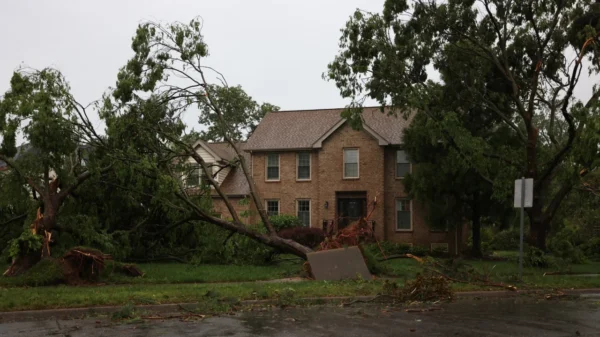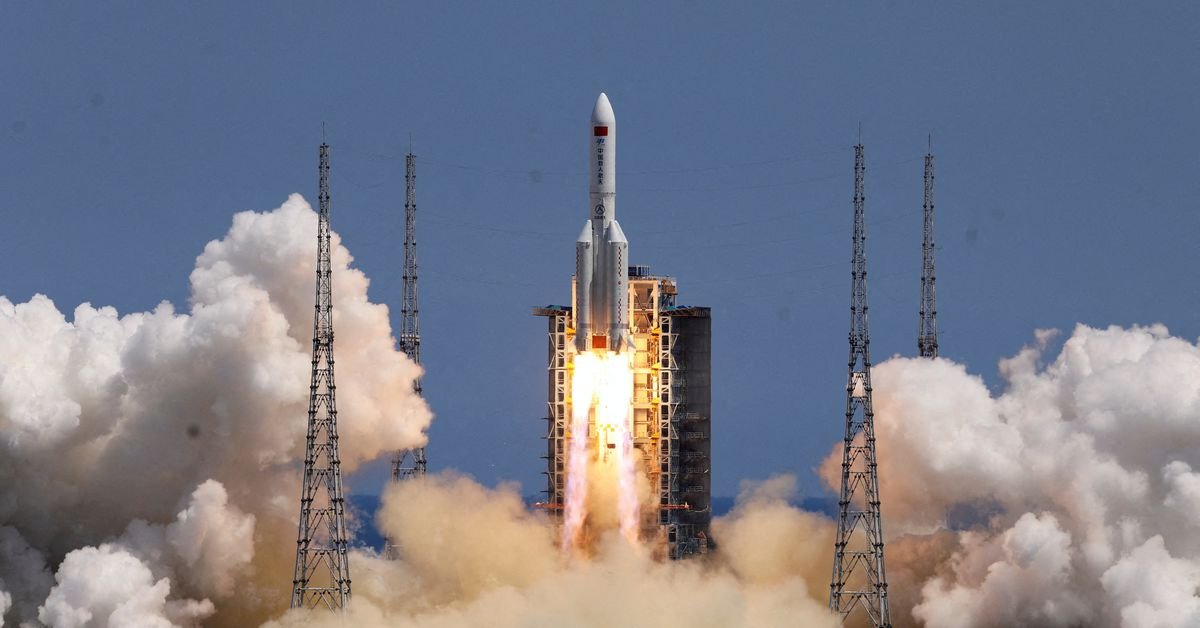A Long March-5B Y3 rocket, carrying the Wentian lab module for China's space station under construction, takes off from Wenchang Spacecraft Launch Site in Hainan province, China July 24, 2022. China Daily via REUTERS
BEIJING, July 27 (Reuters) – Remnants of a large, newly launched Chinese rocket are expected to streak back through the atmosphere this coming weekend in an uncontrolled re-entry the Beijing government said on Wednesday would be closely tracked but poses little risk to anyone on the ground.
The Long March 5B rocket blasted off Sunday to deliver a laboratory module to the new Chinese space station under construction in orbit, marking the third flight of China's most powerful rocket since its maiden launch in 2020. read more
As occurred during its first two flights, the rocket's entire main-core stage – which is 100 feet (30 metres) long and weighs 22 tons (about 48,500 lb) – has already reached low orbit and is expected to tumble back toward Earth once atmospheric friction drags it downward, according to American experts.
Ultimately, the rocket body will disintegrate as it plunges through the atmosphere but is large enough that numerous chunks will likely survive a fiery re-entry to rain debris over an area some 2,000 km (1,240 miles) long by about 70 km (44 miles) wide, independent U.S.-based analysts said on Wednesday.
The probable location of the debris field is impossible to pinpoint in advance, though experts will be able to narrow the potential impact zone closer to re-entry in the days ahead.
The latest available tracking data projects re-entry will occur around 0024 GMT Sunday, plus or minus 16 hours, according to the Aerospace Corp., a government funded nonprofit research centre near Los Angeles.
The overall risk to people and property on the ground is fairly low, given that 75% of Earth's surface in the potential path of debris is water, desert or jungle, Aerospace analyst Ted Muelhaupt told reporters in a news briefing.
Nevertheless, the possibility exists for pieces of the rocket to come down over a populated area, as they did in May 2020 when fragments of another Chinese Long March 5B landed on the Ivory Coast, damaging several buildings in that West African nation, though no injuries were reported, Muelhaupt said.
By contrast, he said, the United States and most other space-faring nations generally go to the added expense of designing their rockets to avoid large, uncontrolled re-entries – an imperative largely observed since large chunks of the NASA space station Skylab fell from orbit in 1979 and landed in Australia.
Overall, the odds of someone being injured or killed this weekend from falling rocket chunks range from one-in-1,000 to one-in-230, well above the internationally accepted casualty risk threshold of one-in-10,000, he told reporters.
But the risk posed to any single individual is far lower, on the order of six chances per 10 trillion. By comparison, he said, the odds of being struck by lightning are about 80,000 times greater.
Chinese foreign ministry spokesman Zhao Lijian said the probability of debris causing harm to aviation or to people and property on the ground was very low. He said most components of the rocket would be destroyed on re-entry.
Last year, NASA and others accused China of being opaque after the Beijing government kept silent about the estimated debris trajectory or the reentry window of its last Long March rocket flight in May 2021. read more
Debris from that flight ended up landing harmlessly in the Indian Ocean.
A few hours after Zhao spoke on Wednesday, the China Manned Space Agency (CMSA) gave the approximate position of its latest rocket in a rare public statement. As of 4:00 p.m. (0800 GMT), the agency said the rocket was circling the globe in an elliptical orbit that was 263.2 km high at its farthest point and 176.6 km high at its nearest.
No estimated re-entry details were given by CMSA on Wednesday.
Our Standards: The Thomson Reuters Trust Principles.
Many in Taiwan have shrugged off China's warnings about a possible trip to the democratic island by U.S. House Speaker Nancy Pelosi, saying they were accustomed to Beijing's sabre-rattling and saw no cause for alarm.
Reuters, the news and media division of Thomson Reuters, is the world’s largest multimedia news provider, reaching billions of people worldwide every day. Reuters provides business, financial, national and international news to professionals via desktop terminals, the world's media organizations, industry events and directly to consumers.
Build the strongest argument relying on authoritative content, attorney-editor expertise, and industry defining technology.
The most comprehensive solution to manage all your complex and ever-expanding tax and compliance needs.
The industry leader for online information for tax, accounting and finance professionals.
Access unmatched financial data, news and content in a highly-customised workflow experience on desktop, web and mobile.
Browse an unrivalled portfolio of real-time and historical market data and insights from worldwide sources and experts.
Screen for heightened risk individual and entities globally to help uncover hidden risks in business relationships and human networks.
All quotes delayed a minimum of 15 minutes. See here for a complete list of exchanges and delays.
© 2022 Reuters. All rights reserved















































